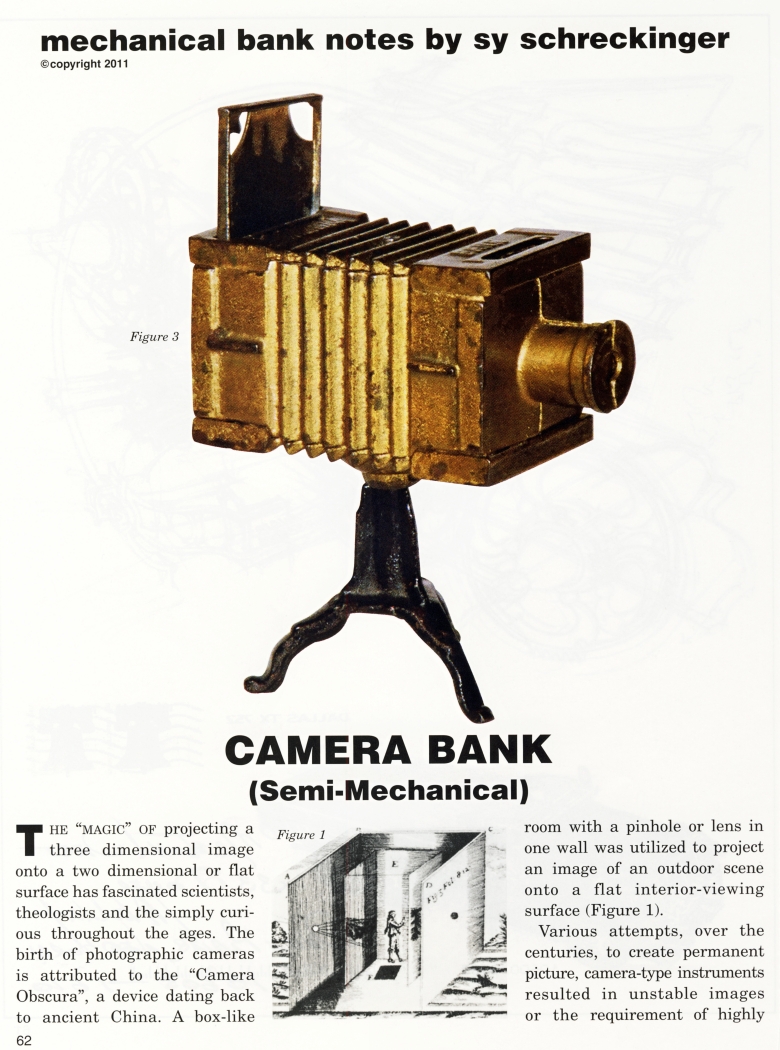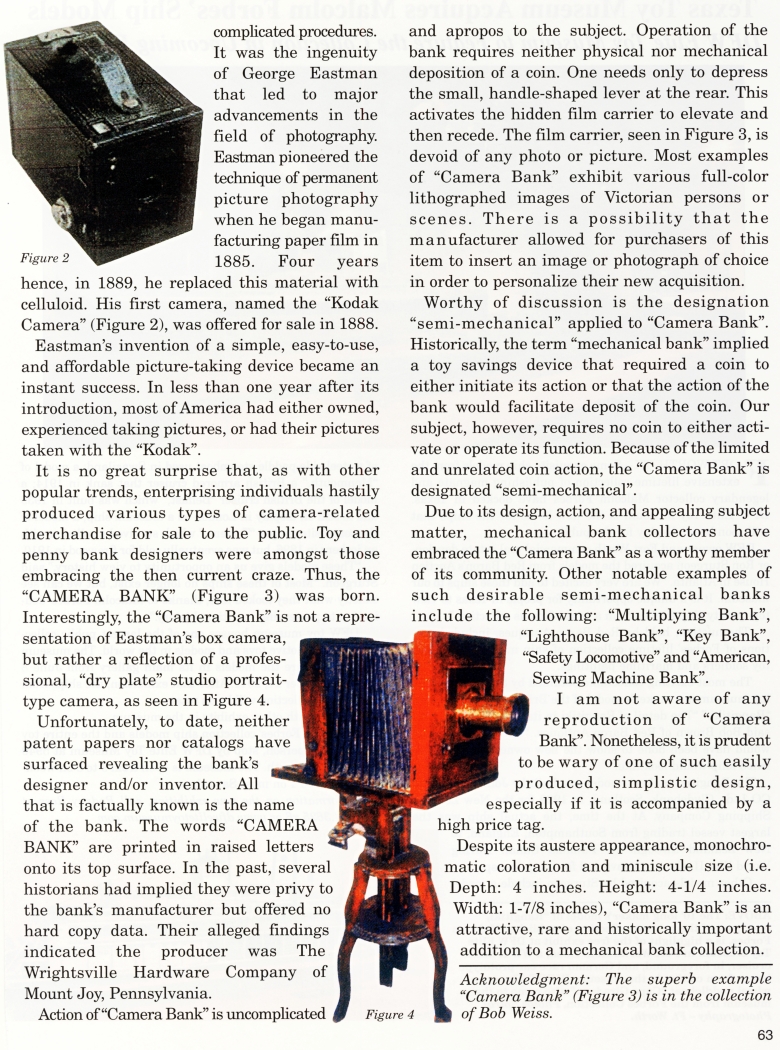|
Camera Bank
(Semi-Mechanical)
by Sy Schreckinger – ANTIQUE TOY WORLD Magazine – October, 2011
THE
"MAGIC" OF projecting a three dimensional image
onto a two dimensional or flat surface has fascinated scientists,
theologists and the simply curious throughout the ages. The birth of
photographic cameras is attributed to the "Camera Obscura", a device
dating back to ancient China. A box-like
room with a pinhole or lens in one wall was utilized to project an image
of an outdoor scene onto a flat interior-viewing surface (Figure 1).
Various attempts, over the centuries, to create permanent picture,
camera-type instruments resulted in unstable images or the requirement
of highly
complicated procedures. It was the ingenuity of George Eastman that led
to major advancements in the field of photography. Eastman pioneered the
technique of permanent picture photography when he began manufacturing
paper film in Figure 2 1885. Four years hence, in 1889, he replaced this
material with celluloid. His first camera, named the "Kodak Camera"
(Figure 2), was offered for sale in 1888.
Eastman's invention of a simple, easy-to-use, and affordable
picture-taking device became an instant success. In less than one year
after its introduction, most of America had either owned, experienced
taking pictures, or had their pictures taken with the "Kodak".
It is no great surprise that, as with other popular trends, enterprising
individuals hastily produced various types of camera-related merchandise
for sale to the public. Toy and penny bank designers were amongst those
embracing the then current craze. Thus, the "CAMERA BANK" (Figure 3) was
born. Interestingly, the "Camera Bank" is not a representation of
Eastman's box camera, but rather a reflection of a professional, "dry
plate" studio portrait- type camera, as seen in Figure 4.
Unfortunately, to date, neither patent papers nor catalogs have surfaced
revealing the bank's designer and/or inventor. All that is factually
known is the name of the bank. The words "CAMERA BANK" are printed in
raised letters onto its top surface. In the past, several historians had
implied they were privy to the bank's manufacturer but offered no hard
copy data. Their alleged findings indicated the producer was The
Wrightsville Hardware Company of Mount Joy, Pennsylvania.
Action of "Camera Bank" is uncomplicated
and apropos to the subject. Operation of the bank requires neither
physical nor mechanical deposition of a coin. One needs only to depress
the small, handle-shaped lever at the rear. This activates the hidden
film carrier to elevate and then recede. The film carrier, seen in
Figure 3, is devoid of any photo or picture. Most examples of "Camera
Bank" exhibit various full-color lithographed images of Victorian
persons or scenes. There is a possibility that the manufacturer allowed
for purchasers of this item to insert an image or photograph of choice
in order to personalize their new acquisition.
Worthy of discussion is the designation "semi-mechanical" applied to
"Camera Bank". Historically, the term "mechanical bank" implied a toy
savings device that required a coin to either initiate its action or
that the action of the bank would facilitate deposit of the coin. Our
subject, however, requires no coin to either activate or operate its
function. Because of the limited and unrelated coin action, the "Camera
Bank" is designated "semi-mechanical".
Due to its design, action, and appealing subject
matter, mechanical bank collectors have
embraced the "Camera Bank" as a worthy member
of its community. Other notable examples of
such desirable semi-mechanical banks
include the following: "Multiplying Bank",
"Lighthouse Bank", "Key Bank",
"Safety Locomotive" and "American,
Sewing Machine Bank".
I am not aware of any reproduction of "Camera Bank". Nonetheless, it is
prudent to be wary of one of such easily produced, simplistic design,
especially if it is accompanied by a high price tag.
Despite its austere appearance, monochromatic coloration and miniscule
size (i.e. Depth: 4 inches. Height: 4-1/4 inches. Width: 1-7/8 inches),
"Camera Bank" is an attractive, rare and historically important addition
to a mechanical bank collection.
Acknowledgment: The superb example "Camera Bank" (Figure 3) is in the
collection of Bob Weiss.
|


